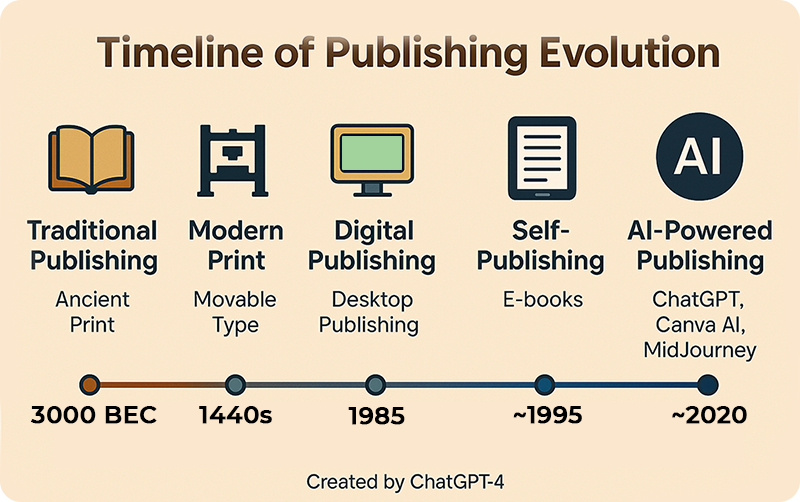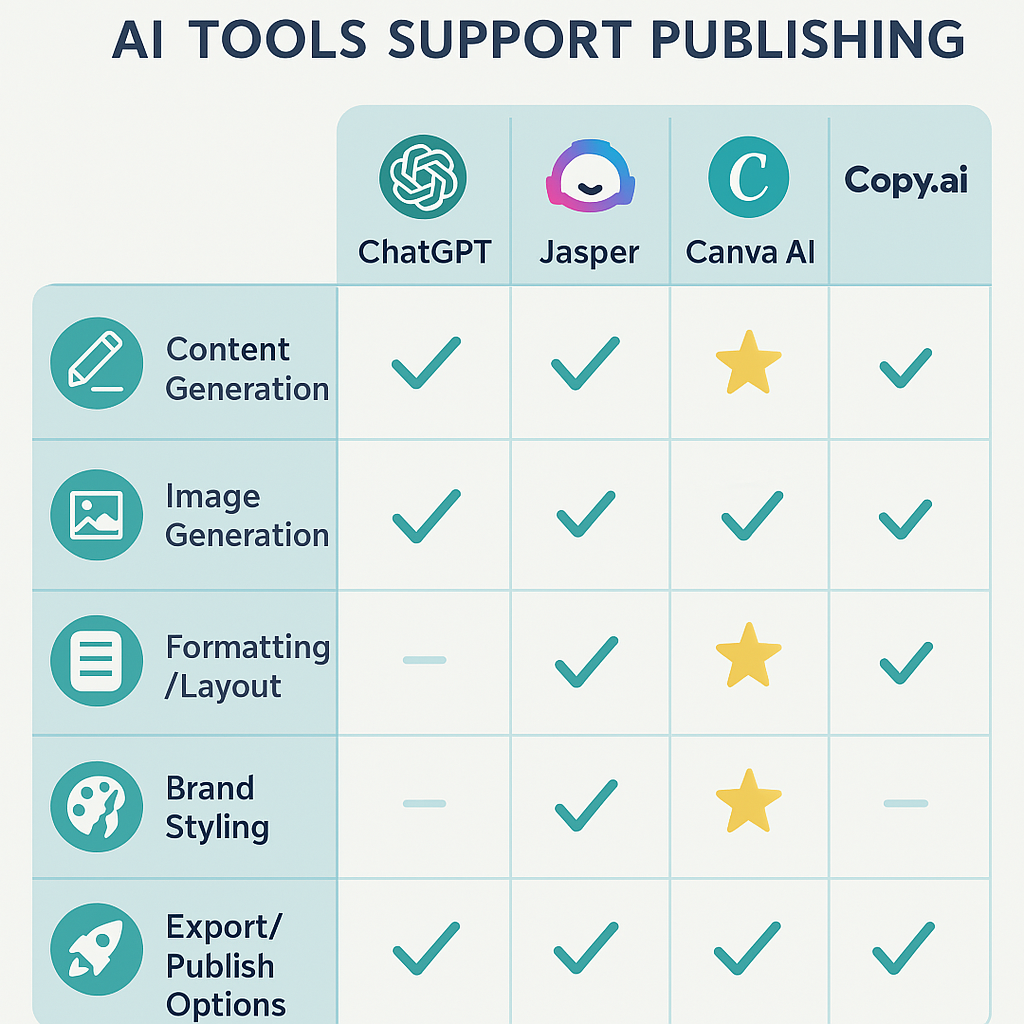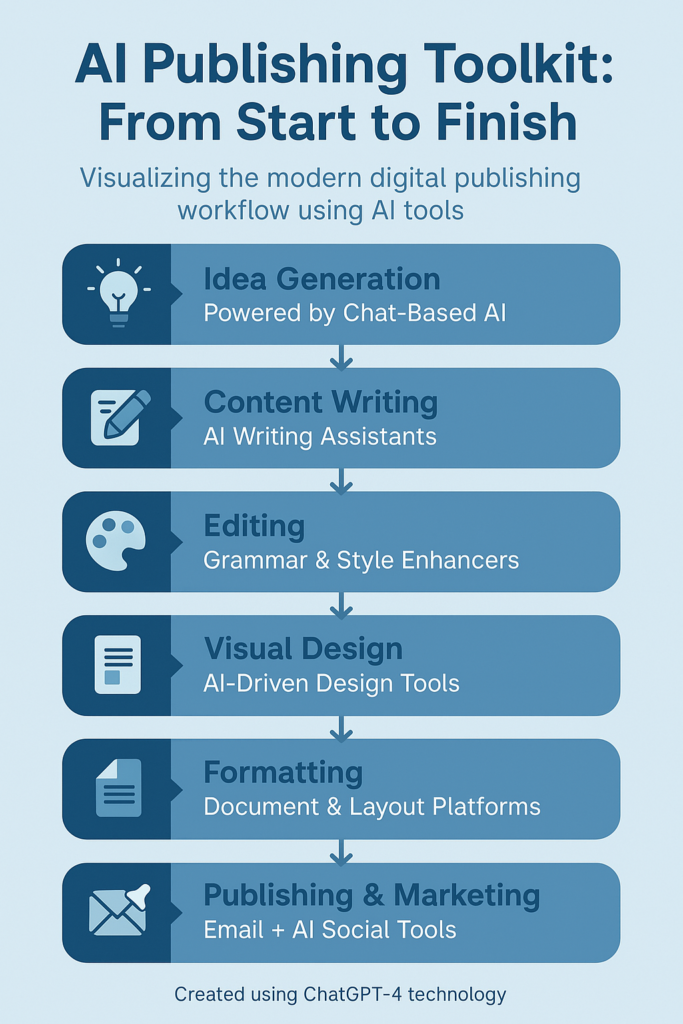Written By: Jerry Warner and ChatGPT-4
Last Updated: April 15, 2025

Introduction: Why AI, Why Now?
Artificial Intelligence (AI) is no longer just a buzzword or science fiction trope—it’s transforming industries, and publishing is no exception. Whether you’re writing your first e-book, launching a digital magazine, or managing an entire content business, AI tools can dramatically improve your workflow, saving time and unlocking new creative potential.
What you’ll learn in this blog:
- The benefits of using AI in publishing
- A breakdown of essential AI tools
- How to get started without tech overwhelm
- Real-world examples of AI-powered publishing
- Tips to keep your content ethical and high quality
The Rise of AI in Publishing
The publishing industry—once dominated by traditional gatekeepers—is now more accessible thanks to digital tools. Self-publishing platforms like Amazon KDP, Canva, and Gumroad opened the doors. Now, AI is kicking them wide open.
AI can help with:
- Writing and editing content
- Designing professional-quality graphics
- Formatting e-books and magazines
- Generating book titles, blurbs, and summaries
- Translating content into other languages
- Automating marketing emails and social media posts

Key Benefits of AI for Digital Publishers
Here are some major advantages of integrating AI into your publishing process:
- Speed and Efficiency
AI writing tools like ChatGPT, Claude, or Jasper can help you draft content quickly. They’re great for outlines, blog posts, product descriptions, and brainstorming.
- Lower Costs
Hiring editors, designers, and marketers can get expensive. AI tools can handle many of these tasks affordably or even free.
- Professional-Quality Design
Tools like Canva with AI features, Adobe Express, and Visme now offer AI-powered design suggestions and templates that are stunning—even for non-designers.
- Fewer Technical Barriers
You don’t have to be a tech wizard. Today’s AI tools are user-friendly, often requiring only a few prompts or clicks to generate results.

Top AI Tools for Publishing (Beginner Friendly)
Here are some recommended tools and how to use them:
🧠 AI Writing & Editing
- ChatGPT (OpenAI) – Best for blog content, email marketing, idea generation, storytelling.
- Grammarly – Helps with grammar, clarity, and tone.
- Sudowrite – AI co-writer geared toward authors and fiction writing.
- Notion AI – Great for summarizing long articles or planning content calendars.
🎨 AI for Graphics & Design
- Canva + Magic Design / Magic Write – Drag-and-drop AI design for social posts, book covers, and more.
- Adobe Express – Fantastic templates for digital magazines and social promos, now with AI text and layout helpers.
- MidJourney / DALL·E 3 – AI art generators for eye-catching covers or illustrations.
📘 Formatting and Publishing
- Atticus – E-book and print formatting software with an intuitive interface.
- Designrr – Turns blog posts or PDFs into eBooks.
- Reedsy – Free book editor with professional templates.

Real-World Use Case: Publishing a Digital Magazine with AI
Let’s say you want to publish a monthly digital magazine. Here’s how AI can make it simple:
Step 1: Plan Your Issue
Use ChatGPT or Notion AI to brainstorm content ideas, titles, and themes.
Step 2: Draft Articles
ChatGPT or Jasper can help you draft feature articles or blurbs based on your outline. You do the final polishing.
Step 3: Design Pages
Use Canva or Adobe Express with templates and AI suggestions to create magazine spreads. DALL·E or MidJourney can generate custom art for covers or features.
Step 4: Format for Publishing
Use Designrr or Atticus to finalize the formatting, then export as PDF or ePub.
Step 5: Promote It
Let ChatGPT help you write promotional emails, headlines, and even social media captions.
Getting Started: A Simple Beginner Workflow
If you’re just starting out, here’s a 3-step entry plan:
- Pick one content type – Start with a short eBook, newsletter, or blog series.
- Choose 2-3 tools to test – For example: ChatGPT for writing + Canva for visuals + Designrr for formatting.
- Create your first project – Don’t aim for perfect—just publish something and learn.
Keep It Ethical: Human Creativity Still Matters
AI is powerful, but you’re still the creative director. Here are some quick tips to keep your content ethical and authentic:
- Always fact-check anything AI writes.
- Avoid plagiarism – Use AI as a co-creator, not a copy-paste machine.
- Infuse your personality – AI can’t replicate your voice, experience, or wisdom.
- Disclose use of AI when appropriate, especially in publishing or client work.

Conclusion
Final Thoughts: AI Is a Tool, You Are the Talent
You don’t need to be tech-savvy to benefit from AI in publishing. Start small. Experiment. Let AI speed up the boring parts so you can focus on creating high-quality, meaningful content.
This is just the beginning of a new creative revolution—and you’re invited.
Recommended Resources
- OpenAI (ChatGPT) – Writing assistant
- Canva – Visual design
- Adobe Express – Layout design with AI tools
- Sudowrite – Fiction AI writing
- Grammarly – Writing polish
- Reedsy Book Editor – Free formatting
- Atticus – eBook + print formatting
- Designrr – Turns content into eBooks